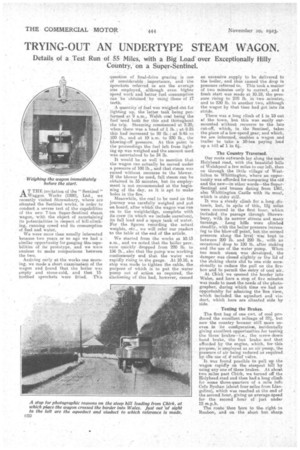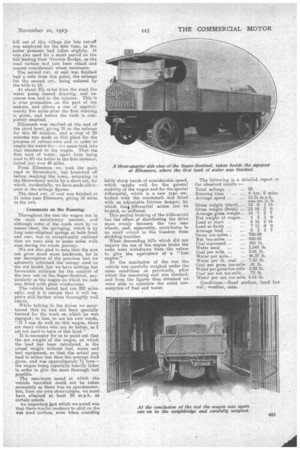TRYING-OUT AN UNDERTYPE STEAM WAGON.
Page 26

Page 27

If you've noticed an error in this article please click here to report it so we can fix it.
Details of a Test Run of 55 Miles, with a Big Load over Exceptionally Hilly Country, on a Super-Sentinel.
AT THE .invitation of the " Sentinel " Waggon Works (1920), Ltd., we recently visited Shrewsbury, where are situated the Sentinel works, in order to conduct a severe test of the capabilities of the new 7-ton Super-Sentinel steam wagon, with the object of ascertaining" its potentialities in respect of hill-climbing, running speed and its conetunption of fuel and water.
We were more than usually interested because two years or so ago we had a similar opportunity for ganging the. capabilities of its prototype, and we were anxious to make comparisons between the two.
Arriving early at the works one morning, we made a short examinatioli of the wagon and found that the boiler was empty and stone-cold, and that 15toothed sprockets were fitted. This
question of final-drive gearing is one of considerable importance, and the sprockets referred be are the average size employed, although even higher speed work and better fuel consumption can be 'obtained.' by 'using those of 17 teeth.
• A quantity of fuel was Weighed oht for lightieg up, the latter task being per:. formed at. 9 a.m., Wejsh coal being the fuelused both for this and throughout the trip. Steaming comnienced at 9.20, when there was a head of 1 lb. ; at-9.25 this had increased to 20 lb. ; at 9.45 to 100 lb., and at 10 a.m. to 230 lb„ the blowing-off pressure. At this point in the proceedings the fuel left from lighting up was weighed and the amount used was-ascertained to be 34 lb.
It would be as well to mention that the wagon can actually be moved under a pressure of 100 lb., and that steam was raised without recourse to the blower. If the blower be used, full steam can be obtained in 35 minutes, but its employment is not recommended at the beginning of the day, as it is apt to make holes in the fire.
Meanwhile, the coal to be used on the journey was carefully weighed and put on board, after which the wagon was run on to the weighbridge, complete with its crew (in which we include ourselves), its full load and a "spaee tank of water. For the figures recording the actual weights, etc., we will refer our readers to the table at the end of the article. •
We started from the works at 10.13 a.m., and we noted that the boiler pres-• sure quickly dropped from 220 lb. to 156 lb., also that the pump was working continuously and that the water was rapidly rising in the gauge. At 10.16, a stop was matte to tighten the cable, the. purpose. of whieh is to put the water pump out of action as required, the slackening of this had, however, caused an excessive supply to be delivered to the boiler, and thus caused the drop in pressure referred to. This took a matter of two minutes only to correct, and a fresh start was made at 10.18, the pressure rising to 210 lb. in two minutes, and to 230 lb. in another two, although. the wagon by that time had got into its stride.
There was a long climb of 1 in 10 out cif the town, but this was easily surmounted without recourse to the late cut-off, which, in. the Sentinel, takes the place of a low-speed gear, and which, we are informed, enables a wagon and trailer to take a 10-ton paying load up a hill of 1 in 61.
The Country Traversed.
Our route outwards lay along the main Holyhead road, with the beautiful hills of Welshpool a. few miles to our left, then on through the little village of Westfelton to Whittington, where an opportunity was afforded for comparing the old and the new—in other words—the SuperSentinel and houses dating from 1361, also Whittington Castle with its moat, which is older still.
It was a steady climb for a long distanc-e, but, in spite of this, 124 miles were covered in the first hour, vithicii included. the passage through Shrewsbury, with its narrow streets and many turnings. Long hills were climbed steadily, with the boiler pressure increasing to the blow-off point, but, the normal pressure along the level was kept to between 200 lb. and 220 lb., with an occasional drop to 180 lb. after stoking and the use of the water pump. When too much steam was developed, the damper was closed slightly or the lid of the stoking chute slid to one. side occasionally to reduce the pull on the fireboxand to permit the entry of cool air. At, Chirk we crossed the border into Wales, and here a stop of five minutes was made to meet the needs of the photo. grapber, during which time we had an opportunity for admiring the -fine View, which included the aqueduct and viaduct, which here are situated side by side.
Testing the Brakes.
The first bag of one cwt. of coal produced the excellent mileage of 24, but now the country became still more uneven in is configuration, incidentally giving excellent opportunities for testing , the three brakes—i.e., the screw-down hand brake, the foot brake. and that afforded by the engine, which, for -this purpose; is employed as an air -pump, the pressure of air being reduced as required by the use of relief valve. It was found possible to pull up the wagon rapidly on the -steepest hill by using any one of these brakes. At about two miles past Chirk, we turned off the Holyhea.d road and then had a long climb for some three-quarters of a mile info Cefii Bychan (about four miles from Ilangellen)., which was reached at the end of the second hour, giving an average speed for the second hour of just under 12. m.p.h.
The route then bore to the right to Ruabon, and on the short but sharp, hill out of this village the late cut-off was employed for the first time, as the boiler pressure had fallen slightly. It was also used for a short period on the hill leading from Overton Bridge, as the road surface had just been relaid and caused 'considerable wheel resistance.
The second cwt. of coal was finished half a mile from this point, the mileage for the second cwt. being reduced by the hills to 13.
At about 3Th miles from the start the water pump ceased drawing, and recourse was had to the injector. This is a wise precaution on the part of the makers, and allows a run of approximately five miles after the first warning is given, and before the tank is completely emptied.
Ellesmere was reached at the end of the third hour, giving 16 as the mileage for this 60 minutes, and a stop of 25 minutes was made at this place for the purpose of refreshment, and in order to empty the water fre.,1 the spare tank into that standard on the wagon. Thus the first tank of water, apart from being used to fill the boiler in the first instance, lasted just over 40 miles.
From Ellesmere we took the main road to Shrewsbury, but branched oil before reaching the town, returning to the Shrewsbury works by a short cut, for which, incidentally, we have made allowance in the mileage figures.
The third cwt. of coal was finished at 11 miles past Ellesmere, giving 16 miles to the cwt.
Comments on the Running.
Throughout the test the wagon ran in the most satisfactory manner, and although some of the roads were by no means ideal, the springing, which is by long semi-elliptical springs at both front and rear, was so exceptionally resilient that we were able to make notes with ease during the whole journey. We are also glad to note that the new cab gives much more headroom, for in our description of the previous test we adversely criticised the canopy used on the old model, but we have nothing but favourable criticism for the comfort of the new cab on the Super-Sentinel, particularly as the wagon on which we rode was fitted with glass windscreens. The vehicle tested had run 200 miles only, and it is certain that it will improve still further when thoroughly well While talking to the driver we ascertained that he had not been specially trained for the work on which he was engaged; in fact, to use his own words, "If I can do well on this wagon, there are many others who can do better, as I am not used to tests of this kind."
It is necessary for us to point out that the net weight of the wagon, on which the load has been calculated, is the actual weight without fuel, water and tool equipment, so that the actual pay load is rather less than the average load given, and was approximately 71tons— the wagon being especially heavily laden in order to give the most thorough test possible.
The maximum speed at which the vehicle travelled could not be taken accurately as there was no speedometer, but, from our own observations, we must have attained at least 25 m.p.h. at certain points.
An important Lad which we noted was that there wasia4 tendency to skid on the wet road surface, even when rounding
fairly sharp bends at considerable speed, which speaks well for the general stability of the wagon and for the special differential, which is a, new type embodied with the crankshaft and fitted with an adjustable friction damper, by whici theviifferential action can be braked, or stiffened. This partial braking of the differential has the effect of distributing the drive more evenly between the two rear wheels, and, apparently, contributes to no small extent to the freedom from skidding troubles.
When descending hills which did not require the use of the engine brake the cams were withdrawn from the valves to give the equivalent of a "free. engine." At the conclusion of the run the vehicle was .carefully weighed under the same conditions as previously, after which the remaining coal was checked, and from the figures thus obtained we were able to calculate the exact consumption of fuel and water.
The following is a detailed report et the observed results :—
Total mileage ... 55 Running time ... ... 4 hrs. 8 mills.
Average speed ... ... 13.3/ m.p.h.
tons. cwt. qr. Ib Gross weight (start), ... 15 0 1 14 Gross weight ;finish) ... '13 14 3 0 Average gross weight... 14 7 2 7 Net weight of wagon... 6 3 3 0
Load at start ... .. 8 16 2 14 Load at finish ... 7 11 0 0 Average load ... 8 3 3 7 Gross ton-miles... 790.80 Net ton-miles ... ... 450.48 Coal copsumed ..325 lb. Water used ... 2,545 lb.
Coal per mile ... 5.91 lb. Water per mile... ... 46.27 lb. Water per lb. coal ... 7.83 lb. Coal per gross ton-mile .41 lb. Water per gross ton-mile 3.22 lb. Coal per net ton-mile... .72 lb. Water per net ton-mile 5.65 lb.
Conditions.—Road surface, hard but wet; weather, calm.
























































